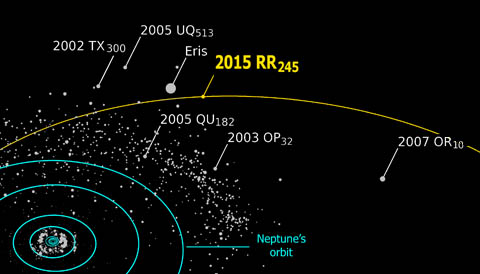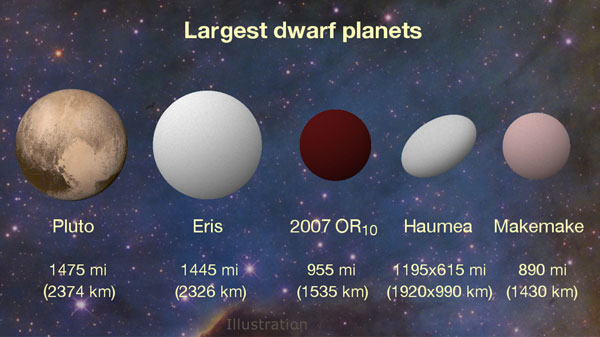First spied last year, an object designated 2015 RR245 turns out to be one of the largest and most distant objects yet found orbiting the Sun.

OSSOS team
Planetary astronomers have been busy of late. The IAU's Minor Planet Center has tallied 1,491 objects in orbits more distant than Neptune ("transneptunians") and another 501 in the outer solar system that occupy odd, usually quite elliptical orbits ("Centaurs" and "scattered-disk objects"). On average, one more gets added to the list about every 5 days.
But a distant discovery announced two days ago has created heightened interest among Kuiper Belt cognoscenti. Designated 2015 RR245, it's some 64 astronomical units (9½ billion km) from the Sun, more than twice Neptune's distance. And despite appearing just 22nd magnitude, it could be as large as 700 km (450 miles) across.
Observer JJ Kavelaars (National Research Council of Canada) first spotted it last September 9th using the Canada-France-Hawaii Telescope atop Mauna Kea. His observations were part of a larger search effort called the Outer Solar System Origins Survey (OSSOS), which since 2013 has paired CFHT's 3.6-m optics with a sensitive camera called MegaPrime that captures fields 1° square.
But it wasn't until Michele Bannister (University of Victoria) and others took follow-up images in February and again in June that the orbit could calculated with any certainty. It turns out that the mean solar distance (81.4 a.u.) and large orbital large eccentricity (0.59) of 2015 RR245 carries it from Neptune's vicinity out to 129 a.u. (19.3 billion km). One trip around the Sun takes about 730 years. Dynamicists already suspect that the new find might be in an orbital resonance with Neptune.
Dwarf Planet or Not?

Alex Parker / OSSOS team
The large estimated size is just that — an estimate — based on its brightness and distance. For example, the 700-km diameter corresponds to having a surface that's 10% reflective, typical of Kuiper Belt objects. But if it's partly ice covered and, say, 25% reflective overall, then the corresponding diameter drops to about 450 km. In both of these examples, the same amount of sunlight gets reflected toward Earth. "It's either small and shiny, or large and dull," Bannister notes in a CFHT press release.
Size does matter, at least when considering whether 2015 RR245 qualifies for "dwarf planet" status. We certainly know where CFHT management stands on this question: its announcement refers to the new discovery as a dwarf planet a half dozen times. But does it really qualify as such?

Konkoly Observatory / NASA / JHU-APL / SwRI
Technically, the International Astronomical Union — specifically its Committee on Small Body Nomenclature (CSBN) and Working Group for Planetary System Nomenclature (WGPSN) — unilaterally get to decide which objects belong to the Dwarf Planet Club. So far only five objects make the official cut: Ceres, Pluto, Eris, Makemake, and newcomer Haumea, which was approved almost a decade ago. "It has not happened for 2015 RR245," says Lars Lindberg Christensen, the IAU's press officer.
However, by invoking the IAU's definition for a dwarf planet, quite a few more objects — perhaps dozens more — would qualify on the basis that they're likely massive enough to be round. Mike Brown (Caltech), who's found a healthy share of the largest KBOs (most notably Eris), calculates that a rocky object at least 900 km across, and an icy one of at least 400 km, probably meets the IAU's "roundness criterion."
Using that metric, Brown counts 10 objects (Ceres, Pluto, and 8 other KBOs) are "nearly certain" to be dwarf planets and another 27 are "highly likely". If 2015 RR245 really is 700 km across, then it too is "highly likely" to qualify as a dwarf planet.
Regardless, the new discovery is yet another distant oddball — albeit a big one — that's giving planetary dynamicists lots of agita (as my Italian grandmother used to say) about how the Kuiper Belt formed and evolved.
 5
5
Comments
Anthony Barreiro
July 14, 2016 at 2:33 pm
Thanks Kelly. Unlike "Planet Nine", this body has actually been observed and characterized, not just hypothesized.
The CFHT press release contains a lot of useful information and links. I wanted to get a sense how 2015 RR245 compares to Pluto. If the albedo guess is correct, 2015 RR245 would be about half the diameter of Pluto. With an orbital period of 735 years, 2015 RR245 takes three times as long to orbit the Sun as does Pluto. 2015 RR245's perihelion distance is about the same as Pluto's, but at aphelion 2015 RR245 is three times as far from the Sun as Pluto ever gets.
You must be logged in to post a comment.
Anthony Barreiro
July 14, 2016 at 2:35 pm
2015 RR245 is currently coming in toward perihelion, in 2092, so it's brighter and moving faster than during most of its orbit.
You must be logged in to post a comment.
July 15, 2016 at 4:42 pm
One thing puzzles me. Haumea seems to be big enough to qualify as "massive enough to force a spherical shape by gravity", yet it appears to clearly not be spherical. Its shape does not look oblate either (and it would require extreme rotation to be that distorted). Is it an unresolved close binary? Or is the estimate of what it takes to force sphericity simply too liberal?
You must be logged in to post a comment.
J. Kelly BeattyPost Author
July 16, 2016 at 11:55 am
the lopsided shape likely results from Haumea's very rapid rotation, just 4 hours. over time that would distort into a triaxial ellipsoid (see http://web.gps.caltech.edu/~mbrown/2003EL61/). the fast spin in turn probably results from a big collision long ago; in addition to having two moons, several other Kuiper Belt objects appears to be chunks of material that originated at Haumea (see http://www.nature.com/nature/journal/v446/n7133/full/nature05619.html). so Haumea is still "round" enough, but it's been distorted into the shape it has now.
You must be logged in to post a comment.
parkerhugh
July 15, 2016 at 4:52 pm
When the new object's orbit is better established, I'd like to see a graph of objects that are dwarf planets, or "nearly certain" to be, and those that are still "highly likely" to be. One axis might be the diameter and the other might be the mass.
You must be logged in to post a comment.
You must be logged in to post a comment.